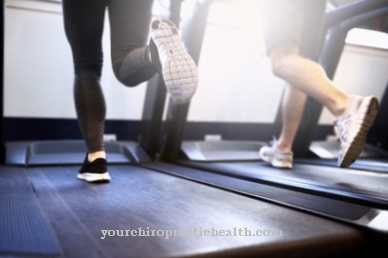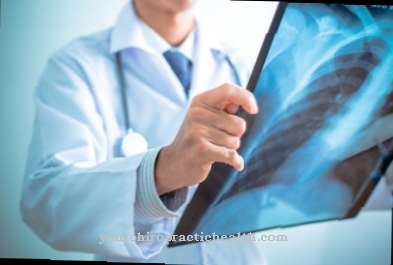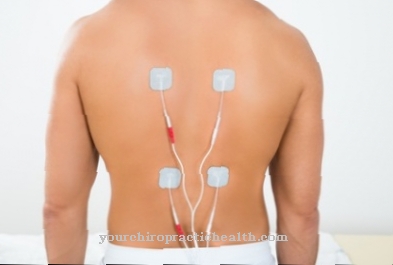In the Venography it is a radiological examination method. It is used to assess the veins.
What is venography?

As a phlebography or Venography is a part of angiography. It is one of the imaging examination procedures. A contrast agent containing iodine is used, which the doctor injects into the vein region to be examined. At the same time, the doctor performs an X-ray examination to record the flow of the contrast medium.
The phlebography is used to visualize shoulder-arm veins, leg veins and pelvic veins. Only in rare cases is it implemented as the first choice. It is often only carried out after a sonography (ultrasound examination). It is helpful to clarify imprecise findings if a blood clot (thrombosis) is suspected. For example, thromboses in the veins of the thigh and the lower leg ligament veins can be clarified particularly well with venography.
Function, effect & goals
The areas of application for a venography include primarily varicose veins (varicose veins), venous thrombosis (phlebothrombosis), a post-thrombotic syndrome and recurrent varicose veins, in which varicose veins develop again.
In addition, phlebography is carried out after unclear ultrasound examinations, if a life-threatening pulmonary embolism is suspected, which is often caused by a postponed leg vein thrombosis, before performing an operative thrombectomy or medicinal thrombolysis and to check the further course of a pronounced phlebothrombosis. Inflammations or tumors that show up in the vein area can also be determined by using a venography.
Before the venography can take place, the patient must first be injected with a contrast medium into the affected vein. The blood in the veins has the ability to flow towards the heart. In this way, a good distribution of the contrast agent is possible. Thanks to the special X-ray examination, the internal vein structure can be shown exactly. The doctor is thus given the opportunity to determine any changes, which include relocations or bottlenecks.
Before performing a venography, the patient must inform the doctor if he has any specific allergies. The patient is not allowed to eat anything about four hours before the examination begins. In some cases, taking a foot bath can also be useful to soften the skin and widen the veins. This in turn allows better venous access to be created.
If a venography is performed on the leg, which is usually the case, the patient lies down on a couch. The feet lean in the lower direction. A tourniquet is placed over the ankle so that the contrast agent can also get into the deep leg veins. The contrast agent is then injected into a vein on the back of the foot. The agent can penetrate the deeper areas of the body through the vein. The next step is to take the x-rays. The doctor looks at the pelvis, thigh, knee and lower leg. The X-ray images are taken from several directions. The leg is turned in the inner and outer direction.
If there is a thrombosis, this can be seen on the image as a filling defect that is sharply delimited. When checking the venous valve function, the patient has to push in a similar way to a bowel movement. In this way, the doctor can determine whether the venous blood is returning and whether the venous valves are tight. In total, the venography only takes 5 to 10 minutes.
After the end of the examination, the leg is firmly wrapped. A support stocking can also be put on. In order to better remove the contrast medium, the patient should move about 30 minutes. The excretion of the agent takes place through the kidneys. The patient must therefore drink plenty of fluids.
If venography alone is not sufficient for diagnosis, there is also the option of CT venography, in which the veins are examined by computer tomography, or magnetic resonance venography, which can be carried out with or without a contrast medium.
Risks, side effects & dangers
When doing a venography, some side effects are possible. This includes, for example, bleeding at the injection site. Some patients also have infections or scarring. The contrast agent can also irritate the walls of the veins or trigger allergic reactions.
If there is a thrombosis, it is possible that a clot of blood loosens and penetrates to other parts of the body. If the doctor inserts a catheter, there is a risk that the vein wall will be punctured by the instrument or needle.
In addition to the risks and side effects, there are also some contraindications to consider. This primarily includes a possible intolerance of the patient to the contrast agent. Further contraindications are chronic lymph congestion, acute inflammation in the shoulder-arm region, on the foot or on the lower leg, and an overactive thyroid. For these reasons, the patient must be informed by the doctor before performing the venography exactly about the risks and side effects of the procedure, which also includes the x-ray exposure. Sometimes other procedures that are not invasive may be more useful for the exam.
Phlebography has both advantages and disadvantages. Their greatest advantage is the complete display of the venous vascular system. Functional peculiarities are clearly visible on the x-ray. However, radiation exposure is seen as a minus point. The contrast medium also puts stress on the kidneys. Furthermore, the radiological equipment technology is associated with higher costs.




.jpg)








.jpg)

.jpg)
.jpg)











.jpg)